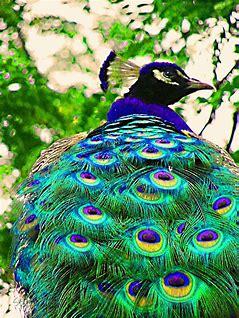Peacocks, with their resplendent plumage and majestic presence, have long been a source of inspiration for artists. The vibrant and intricate patterns of their feathers make them a captivating subject for painters seeking to bring a burst of color to their canvases. In this article, we will explore the art of peacock painting and the techniques to create a stunning masterpiece that captures the essence of these magnificent birds.
Table of Contents
- Introduction to Peacock Painting
- Gathering Inspiration and Reference
- Selecting the Right Materials
- Preparing the Canvas
- Sketching the Peacock
- Creating a Color Palette
- Building Layers and Textures
- Adding Detail to the Feathers
- Highlighting Iridescence and Shine
- Background and Composition
- Finishing Touches and Fine-Tuning
- Conclusion
1. Introduction to Peacock Painting
Peacock painting is an opportunity for artists to unleash their creativity and explore the vibrant world of colors. It allows you to capture the elegance and beauty of peacocks, translating their intricate feathers into a visual symphony on canvas. Whether you are a beginner or an experienced artist, peacock painting offers a delightful artistic journey.
2. Gathering Inspiration and Reference
Start by immersing yourself in the world of peacocks. Seek inspiration from photographs, artwork, and even observing these birds in person. Study the details of their feathers, their regal posture, and the overall grace they exude. Use these references as a guide and to spark your imagination.
3. Selecting the Right Materials
Choose high-quality materials that suit your preferred medium, whether it’s acrylics, oils, or watercolors. Invest in professional-grade paints, brushes, and canvas to achieve the desired results. Experiment with different brushes, from fine to broad, to create varied textures and brushstrokes.
4. Preparing the Canvas
Prepare the canvas by applying a primer or gesso to create a smooth surface. This helps the paint adhere better and ensures longevity. Allow the primer to dry completely before moving forward.
5. Sketching the Peacock
Start by sketching the basic outline of the peacock on the canvas. Pay attention to the proportions, posture, and the placement of the head, body, and tail. Use a light pencil or a thin brush with diluted paint to create the initial sketch. Adjust and refine the sketch until you are satisfied with the overall composition.
6. Creating a Color Palette
Peacocks are known for their vibrant and iridescent feathers. Create a color palette that reflects the blues, greens, purples, and golds found in their plumage. Experiment with mixing different shades and tones to achieve a harmonious balance. Consider using complementary colors to enhance the visual impact.
7. Building Layers and Textures
Begin by painting the base layer of the peacock’s body and feathers. Start with broader brushstrokes and gradually build up layers to create depth and texture. Pay attention to the direction and flow of the feathers, using brushstrokes that mimic their natural patterns. Allow each layer to dry before applying the next to avoid muddying the colors.
8. Adding Detail to the Feathers
Peacock feathers are known for their intricate patterns. Use smaller brushes or even fine liners to add the delicate details to the feathers. Create lines, dots, and other markings that bring the feathers to life. Take your time and work patiently, focusing on each individual feather and its unique characteristics.
9. Highlighting Iridescence and Shine
To capture the iridescence and shine of peacock feathers, layer different shades of the chosen colors. Apply glazes or dry brush techniques to create a luminous effect. Add highlights and reflections using lighter tones to give the feathers a three-dimensional appearance. Pay attention to the interplay of light and shadow to enhance the overall realism.
10. Background and Composition
Consider the background and composition of your painting. Choose a background color or texture that complements the peacock’s vibrant feathers. A simple and unobtrusive background can allow the peacock to take center stage. Experiment with different techniques, such as washes or splatters, to add visual interest and depth.
11. Finishing Touches and Fine-Tuning
Step back and evaluate your peacock painting as a whole. Make any necessary adjustments, refine details, and add final touches to enhance the overall impact. Add additional highlights or shadows to create depth and dimension. Take your time during this stage to ensure a polished and cohesive artwork.
12. Conclusion
Peacock painting offers a delightful and creative journey into the world of vibrant colors and intricate patterns. With the right materials, techniques, and attention to detail, you can create a stunning masterpiece that captures the allure of these magnificent birds. Embrace your creativity, let your imagination soar, and enjoy the process of bringing a symphony of colors to life on canvas.
